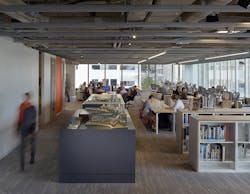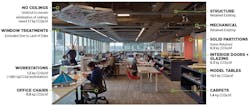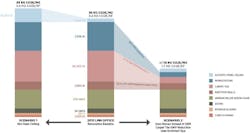It’s often noted that the built environment contributes 40% of carbon emissions worldwide. Architects and facilities professionals have responded to this number by attacking carbon emissions on two fronts; architects have worked to reduce the embodied carbon in common materials like concrete and steel, while facilities teams have focused on reducing energy use and implementing renewable energy as a way to reduce dependence on fossil fuels, which release emissions as they’re burned.
But this conversation has so far left out the impact of building interiors—and according to new research by LMN Architects, the carbon footprint of interior design may be bigger than anyone realized.
“Everybody thought [the impact] was zero because they didn’t measure,” explained Kjell Anderson, principal and director of sustainable design for LMN Architects. “You need to draw the circle a bit bigger to know what your impacts are.”
[Related: Why Buildings that Battle Carbon Are Needed in the Fight Against Climate Change]
How Interiors Affect Carbon Emissions
Anderson and colleague Jenn Chen, a principal interior designer for LMN, used the firm’s own Seattle office to test their theory that interior design—and specifically, cyclical renovations that repeatedly replace interior products—were responsible for considerable carbon emissions. Chen and Anderson decided to analyze several past renovations of the office space using a tool by the Carbon Leadership Forum to estimate the relative carbon impacts of different interior products used in the renovations. The firm moved into Seattle’s Norton Building in 1984 and has done a major renovation about every nine years, making it the perfect case study for Chen and Anderson’s investigation.
The Carbon Leadership Forum tool uses product data from Environmental Product Declarations (EPDs), which were of course not available for the earliest renovations. Chen and Anderson substituted comparable materials that did have EPDs available, which means that their estimate of the carbon impact of interiors is a conservative one—it’s likely that older products have a larger carbon footprint than modern products that have EPDs.
[Related: New Building in Spokane to Become Largest Net Zero Energy and Carbon Building in North America]
Even so, the results are stark. In spaces that undergo cyclical renovations, the cumulative carbon impact of interiors can actually surpass the emissions generated by building the structure and envelope. The structure and envelope are only built once unless you’re constructing an addition, but interiors change relatively frequently.
“When you think about the building when it’s first built, the embodied carbon of the envelope and structure seems really high compared to the interiors, and that’s why it wasn’t part of the conversation for a long time,” Chen said. “But when you take into consideration the cyclical nature of interiors and how often things get remodeled, the embodied carbon of the interiors really adds up.”
What to Do About Interior Embodied Carbon
All is not lost when it comes to the embodied carbon of interiors. All spaces will need a renovation eventually, but there are ways to lower the renovation’s carbon impact. Try these strategies for lowering the carbon footprint of your interiors.
1. Think about what you can reuse. You don’t have to gut spaces to renovate them. You may be able to reuse or repurpose materials you already have, which will save both carbon and money.
2. Save what you can. If you can’t use a material again in your renovation, chances are someone else can. Many cities have architectural salvage programs to which you can donate materials and furnishings. “What can I salvage and reuse on this project or what can be reused by somebody else?” Anderson asked. “Salvage walkthrough sometimes doesn’t happen, but it really should happen on projects because there’s value there.”
3. Specify products salvaged from somewhere else. There are several handy tools out there that can help you find furniture and other products that have been salvaged from previous owners. Doors Unhinged is a pioneer in the space that has diverted scores of doors from the waste stream. Heirloom Design, a digital platform for refinishing and reselling commercial-grade furniture, is another.
4. Opt for lower-carbon alternatives. Manufacturers are starting to address the carbon impacts of their products with strategies like incorporating recycled materials and improving manufacturing efficiency. One such manufacturer, Interface, has reduced the embodied carbon of its carpet tile by 76% since 1996 by changing how it makes its products.
“What you do is make the best decisions and really think about the impact of everything you’re putting into your design,” Chen advised. “Just slow down, examine how the practice has been and whether that serves our environment the best, and what we can change now to do it. Just examine one material to start and you can start building that habit and muscle memory to make a bigger impact.”
About the Author
Janelle Penny
Editor-in-Chief at BUILDINGS
Janelle Penny has been with BUILDINGS since 2010. She is a two-time FOLIO: Eddie award winner who aims to deliver practical, actionable content for building owners and facilities professionals.




